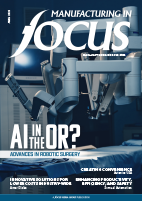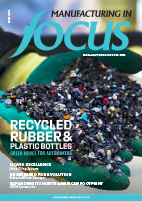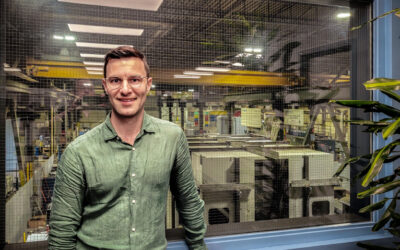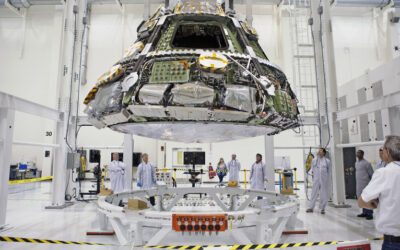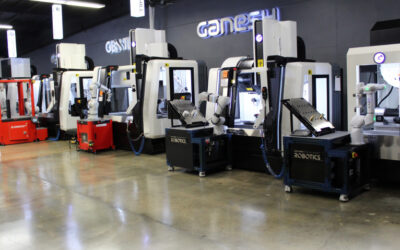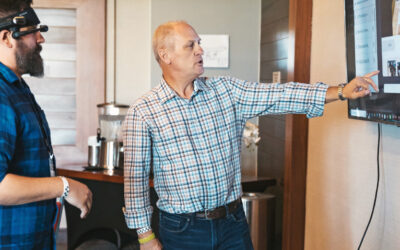For almost twenty-five years, Michigan-based Creative Automation, Inc. (CAI) has provided business with a range of sophisticated automation solutions from its 50,000-square-foot facility in Whitmore Lake. CAI is a leader in state-of-the-art, customized, integrated automation systems.
~
CAI founder Bernd Walter previously worked in the aerospace sector and as a salesman for machine tools. He gained experience in automation while serving as president of the American arm of German manufacturing company SIG Automation. After purchasing SIG’s U.S. material handling division, Walter went on to found CAI and become its chief executive officer, a position he holds to this day.
One of Creative Automation’s first hires was Gerd Walter, the founder’s son. The young Gerd started in CAI’s shipping and receiving department and learned everything possible about the automation industry first-hand. “I was employee number seven,” says Gerd Walter. He became Creative Automation’s president and chief operating officer in April of 2017.
CAI was a pioneer in automation systems and integrated its first robot from robotics and manufacturing automation leader FANUC in 1998. The next year, CAI introduced the TRT vacuum cleaning system – a new way of cleaning parts – to the North American market.
The company became a Level 1 integrator for FANUC Robotics in 2007 and a Level 3 integrator in 2007. It offered its first dispensing system and established its office in China in 2009.
Growing in both services and locations, CAI introduced a deburring system and established its Mexico office in 2010. The company earned certified robotic systems integrator status with trade group Robotic Industries Association (RIA) in 2014. The prestigious Michigan-based group was created to serve the robotics sector.
“We are very active in the RIA,” says Walter. Among the association’s membership are many vendors and equipment suppliers for integrators like CAI, and it provides valuable networking opportunities and a way to meet companies directly to discuss specific engineering challenges and solutions.
“The RIA also has a certified robot integrator program, and we are certified there,” he says. “That helps tell people that we are qualified, we are not some garage-based company. We are a substantial company. We do a lot of robots, and we know what we do.”
Creative Automation’s specializes in creating custom automation systems whether semi-automated or fully-automated. CAI’s highly-trained team collaborates with clients to design and optimize systems for dispensing, deburring, palletizing, or machine tending.
CAI is often faced with challenging tasks such as when it was approached by a maker of air filtration systems for commercial applications. The company worked to develop a unique automated dispensing solution which was significantly more efficient and cheaper than the client’s labor-intensive manual process, which had six stations requiring four gaskets to be applied simultaneously.
Working closely with the customer’s designer and contractor over a six-month period, CAI created a system which was tested in-house before shipping to its final destination, where it was reassembled and tested again. It also provided training at the client’s facility to ensure the system was functioning efficiently and safely.
“With the automatic dispensing system, our customer was able to apply all four gaskets at once,” states the company. “In addition to substantially increasing the quality of the part, the customer also saved time – they were able to man the stations with two employees instead of six while simultaneously increasing throughput. Finally, the customer produced less scrap, amounting to significant cost savings over time.”
Creative Automation’s expertise as a certified robotics integrator ensures clients that the company is informed about the latest systems, technologies, and industry trends, including three-dimensional (3D) printing and other advancements.
One of the most recent technologies is 3D bin picking. One issue facing manufacturers is parts becoming jumbled together in a bin, resulting in time being spent sorting them. To solve this, CAI is using a 3D vision system to automatically guide a robot to select parts, such as an eight-pound steel billet. “The cameras look in three dimensions. Launched last year, it is gaining considerable attention,” says Walter.
Creative Automation’s experience enables the company to create turnkey solutions for clients that are not only effective but cost-efficient.
The company wants to get systems online as soon as possible, so its turnaround averages between sixteen and twenty-eight weeks, depending on the size and complexity of the project. “We can do the full integration here,” says Walter. The company usually tests systems in-house first, then encourages clients to come and watch the system in operation or control it themselves to ensure everything is running just as expected and to their satisfaction before shipping.
The company works primarily in the NAFTA market of the U.S., Canada, and Mexico, with about twenty-five percent of its business in Mexico, but it has taken on projects in other locations, such as Europe and the Philippines. CAI is active in a number of automotive and OEM supply plants serving markets in North America, and South America.
The company has seen an increase in several areas including assembly systems for heavy truck components – primarily brakes – and automated dispensing systems used by customers in air filter manufacturing and door gaskets. These robotic dispensing systems are also a part of window making, dispensing resins to seal or hold together window framing materials.
While it promotes itself through a variety of means such as tradeshows, its YouTube channel, and by dealing with other machine tool manufacturers, Creative Automation continues to receive word of mouth business and praise from satisfied customers.
CAI and its team of about fifty include mechanical engineers with associates degrees or holding a Bachelor of Science in Mechanical Engineering (BSME), highly-experienced robotics and automation sales engineers, controls engineers, robot programmers, trained machine builders, machine electricians, and support staff.
Like many businesses, CAI has its challenges when it comes to finding younger shop floor workers, but plans to keep growing and broaden its reach into new markets.
“I can see the potential to grow our Mexico business and service Mexico and farther south,” says Walter. “So we intend to keep growing and enter some new segments. Automotive is our bread-and-butter, but it’s got it cycles. It’s got some potential long-term strategic challenges that we have to protect against, primarily with the transformation from gasoline engines to electric vehicles.”



